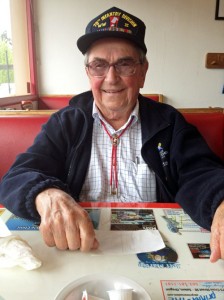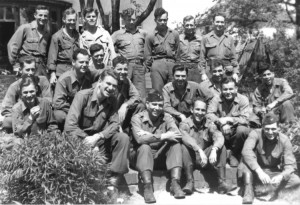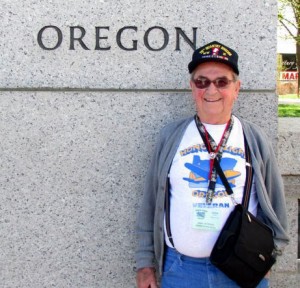
By Mary Owen
Seventy years ago, a 20-year old country boy went into combat to help push enemy troops out of Alsace and Lorraine, two historic provinces in Eastern France.
“The snow was deep, the cold was biting, reportedly the worst in 40 years, and for the American soldiers, the Germans and the citizens of Wingen-Sur-Moder, it was hell,” Vern Staley, now 91, told those gathered in January at a ceremony commemorating the liberation of the town from the German Army on Jan. 7, 1945.
“Some memories are absolutely clear, others are very blurred, but we will never forget,” Staley said.
Born and raised in Prineville, Staley was drafted into the U.S. Army after graduating from Crooks County High School in 1943.
He trained at Camp Adair near Corvallis and three weeks later was moved by troop train to Ft. Leonard Wood in Missouri.
“Our days there were spent in field training, practice maneuvers and various forms of preparation and equipment cleaning,” said Staley, who served as a medic with the 70th Infantry Division, 9th District, 7th Army (F/274).
“One day the entire company assembled, and each man had to fill out a will on a form provided by the Army.”
Eventually, Staley’s regiment, nicknamed the Trailblazers after Oregon’s sturdy pioneers, was transported to Camp Miles Standish just outside of Boston.
“We had Thanksgiving at the camp, and then on Dec. 1, boarded a converted luxury liner, The Mariposa, ending up 10 days later in Marseilles,” Staley said. “We lived on a bare hill for about a week before being taken by railroad boxcars to Bischwiller. By dark, we marched to an old factory where we spent the night. The next day, Dec. 26, we went by river to Wingen-Sur-Moder to push out the Germans. That was our Christmas present!”
After 89 days of combat that caused enormous casualties, the town was secured, and until July 1946, the U.S. Army occupied the area. Staley served as a supply sergeant.
Back on American soil, the regiment was deactivated in October of that year.
“We were all young – college students, farmers, laborers and tradesman,” said

Staley is a retired machinist who lives in Stayton. He recalled the men he served with during World War II.
“Some were barely married with young children. More were barely 18 years old. We had never been in combat. We weren’t even a full division. Our artillery, engineers and other support troops were still back in Boston waiting for a ship to bring them to France,” Staley said.
Staley said the fighting reduced Wingen-Sur-Moder into a “destroyed, smoldering mess.”
“Almost 600 had been killed, wounded or captured,” he told those gathered at the January event. “I still can see them being marched out of town the next day – a wounded officer carried in a chair by his soldiers. They seemed defeated and broken.
“We remember the frightened citizens, cautiously venturing out of cellars on the morning of Jan. 7,” he added. “We wondered what would happen here, but Wingen has remained a part of France for the past 70 years, without foreign oppression or being caught in the crossfire of foreign armies.”
Staley returned several times to the area to celebrate peace and remember those who were lost.
As president of the Trailblazers Association, he will head a delegation of his fellow veterans to Alsace-Lorraine in June.
“Fifty-three are going,” said the father of two and great-grandfather of two. “As we get older, our numbers are dwindling.”
Staley most recently visited Washington, D.C., with other veterans via Oregon’s Honor Flight.
The Honor Fight Network was created solely to honor America’s veterans for their sacrifices, and top priority is given to senior veterans, primarily World War II survivors, and veterans with terminal illnesses.
During the April 17-19 trip, Honor Flight Oregon honorees visited the World War II Memorial, Arlington Cemetery, Lincoln Memorial, Smithsonian National Air and Space Museum, and other memorials.
For his participation, Staley earned a commendation from Gov. Kate Brown and received a framed certificate thanking him for serving his country.

The philosophy behind the Honor Flights is: “Since America felt it was important to build a memorial to the service and the ultimate sacrifice of her veterans, the Honor Flight Network and Honor Flight of Oregon believes it’s equally important that they actually get to visit and experience their memorial.”
“I was so honored,” Staley said of the experience, one of many taking place for this historic anniversary.
“I was recently interviewed by the manager of the Trail Blazer basketball team,” he said. “It will be shown during the sixth winning game, and myself and a couple of others will be comped to attend.”
Staley isn’t holding his breath for a showing this season.
“That’s four more games in a row they’d have to win,” he said, chuckling. “It will be tough. More than likely it will be next season before they win their sixth game.”
Staley has come a long way since training in the spring of 1944 at Camp Adair.
“My first impression could be summarized in two words – wet and soggy,” he said of his time there. “The poncho was our daily dress marching to and from the rifle range.”
Staley recalls the “flowery words that accompanied our orders transferring us to the infantry.”
“It went something like this,” he said. “‘The Army Ground Forces needs intelligent young men to fill the depleted ranks of the infantry so we can finish off the enemy.’”
After engaging in exercises in the hills of Oregon and in the muddy, red soil of Missouri, after walking his legs off on forced marches over Coffin Butte or Prune Ridge, and after enduring tedious inspections and other repeated exercises, Staley said he began to wonder where intelligence fit into the picture.
“However, the camaraderie was great, and in actual combat, we found that intelligence was important, but not as important as loyalty, courage in spite of fear, and the willingness to expose yourself to enemy fire to get the job done,” Staley said. Hesitating momentarily, he shared, “We always thought we would win!”
For his service on the front lines, Staley was awarded a Combat Medics Bade, a Unit Citation, and a Good Conduct Medal. For information on his unit see trailblazersww2.org; for information on Honor Flight go to honorflight.org.
